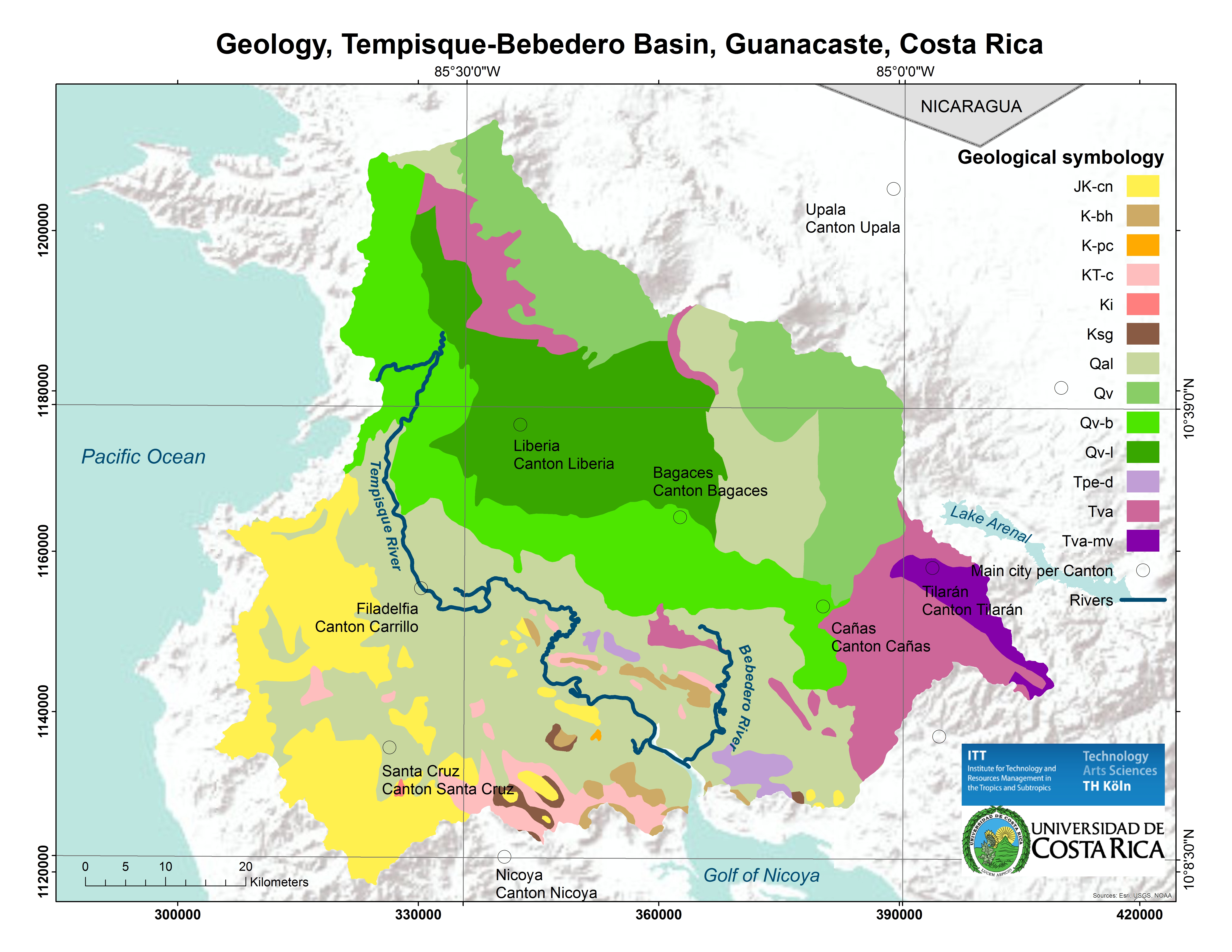Tempisque-Bebedero Basin (Costa Rica)
Natural Environment
Geomorphology
The Tempisque is the third longest river in Costa Rica (136 km) and drains into the Gulf of Nicoya in the North Pacific Ocean. The continental divide denoted by the active volcanoes (from NW to SE) Orosí, Cacao, Rincón de la Vieja (1916 m a.s.l., highest elevation), Miravalles and Tenorio form the catchment’s boundary in the east (Figure 1). A relatively low mean elevation of 260m a.s.l. and a mean slope of around 6° characterize the catchment system. The drainage density (total stream length/ total drainage area) is also relatively low compared to the rest of the country (0.5 at a scale of 1:200,000). The latter results in rivers with a low transport capacity particularly in the large lowlands and floodplains with the main channel of the Tempisque slowly meandering towards the Gulf of Nicoya (Photo 1).

Geology
The geological map (Figure 2) of the study area shows recent quaternary and older Pleistocene volcanic material dominating the higher elevation areas. Quaternary alluvial deposits form part of the floodplains, and towards the east of the Nicoya Peninsula increasingly older sedimentary rocks (limestone and sandstones) dominate the lithology.

Table 1: Description of the geological symbology for the Tempisque-Bebedero Basin used in Figure 2.
| Symbol | Rock Type | Formation | Age | Description |
| JK-cn | Hard | Nico Complex | Jurassic to superior Cretaceous | Igneous and sedimentary origin |
| K-bh | Hard | Barra Honda | Later upper Campanian | Macezza Limestone or Stratifications of the system of muddy platform |
| K-pc | Compact | Puerto Carrillo | Superior Santonian - Campanian | Polymictic Breccia, Basalt, Ultrabasic rocks, Sedimentary Clast |
| KT-c | Compact | Curu | Med/sup Maastrichtian - Pale | Cyclic sequences of Sandstone and Lutites, some Conglomerates |
| Ki | Hard | Nicoya Complex Intrusive | Cretaceous | Gabbro, Diabase, Diorite |
| Ksg | Hard | Sabana Grande | Mid-superior Cretaceous | Calcareous Lutites, Radiolarites and Pelites |
| Qal | Unconsolidated | Quaternary alluvial | Aluvial, coluvial and costal deposites | |
| Qv | Hard | Recent volcanic | Volcanic material: lavas, tuff, Piroclasts | |
| Qv-b | Fragile | Bagaces | Superior Miocene-Pliocene | Dacite tuff, mainly lgnimbrite, Lake sediments |
| Qv-l | Fragile | Liberia | Late Pleistocene | Ignimbrites formed from the accumulation of various ash |
| Tpe-d | Compact | Descartes | Superior Palaeocene- Superior Eocene | Cyclic alternation of Sandstone and Lutite sequences |
| Tva | Semi hard | Guanacaste | Superior Cretaceous- Palaeocene |
Volcanic lithology. Basal and andesite lavas |
| Tva-mv | Hard | Monteverde | Pleo-Pleistocene | Andesite lava flows and pyroclastic rocks associated |
Source: Tecnológico de Costa Rica, TEC, 2014.
Soils
The younger and less developed soils (Entisols and Inceptisols) are mostly located in the floodplains. The volcanic Andisols are predominantly found in the highlands closer to the volcanoes (from NW to SE) Orosí, Cacao, Rincón de la Vieja. The Entisols are predominantly located mixed with Andisols, and are characterized by less pedogenic development likely due to the steep topography facilitating erosion processes. The Mollisols are the most productive soil with intense agricultural use close to the river banks of the Tempisque and to the east towards the Bebedero river. The soils Alfisols and Enfisols are located to the SW of the basin with Ultisols mostly found towards the SE.

Land Use
The forest cover in the province of Guanacaste is composed of secondary forests and primary dry tropical rainforest. Tree plantations using Teak, Melina and Pochote trees are increasing since the 1980s. The land used for agriculture includes annual, permanent and ornamental crops (Table 2). In the Tempisque-Bebedero basin the most important crops are sugar cane, melon and rice, which need irrigation (Figure 4). The pasture areas are mainly used for cattle production and has been a historical factor causing most of the deforestation up to the 1970s. Since the 1980s, forest cover is increasing due to a deforestation ban and environmental protection initiatives.
Table 2: Cultivated land and different crop types of the Guanacaste region in hectares.
| Annual crops | Rice | Melon | Corn | Beans | Watermelon |
| 24 313 | 4 417 | 3 545 | 3 190 | 554 | |
| Permanent crops | Sugar Cane | Orange | Coffee | Mango | Plantain |
| 35 755 | 8 990 | 1 623 | 1 502 | 218 | |
| Forest crops | Teak | Melina | Pochote | Cypress | Guayaquil |
| 20 308 | 2 447 | 2 413 | 327 | 170 | |
| Ornament crops | Live plants | Foliage | Flowers | ||
| 95 | 30 | 18 |
Source: Instituto Nacional de Estadística y Censos, INEC, 2014.

References and further reading:
Fondo Nacional de Financiamiento Forestal FONAFIFO (2012) Estudio de cobertura forestal de Costa Rica 2009-2010.
Instituto Nacional de Estadística y Censos, INEC (2014) VI Censo Nacional Agropecuario.
Magaña, V., Amador, J.A., and Medina, S. (1999) The midsummer drought over Mexico and Central America. J. Climate, 12 (1967): 1577-1588, doi: http://dx.doi.org/10.1175/1520-0442 (1999)012<1577:TMDOMA>2.0.CO;2.
Peel, M. C., Finlayson, B. L., and McMahon, T. A. (2007) Updated world map of the Köppen-Geiger climate classification. Hydrol. Earth Syst. Sci., 11, 1633-1644, doi:10.5194/hess-11-1633-2007.
Tecnológico de Costa Rica, TEC (2014) Altas de Costa Rica.
Waylen, M.E. (1996) Interannual variability of monthly precipitation in Costa Rica. J. Climate, 9: 2606-2613, doi: http://dx.doi.org/10.1175/1520-0442(1996)009<2606:IVOMPI>2.0.CO;2.
WorldClim global product: http://www.worldclim.org/tiles.php?Zone=23

